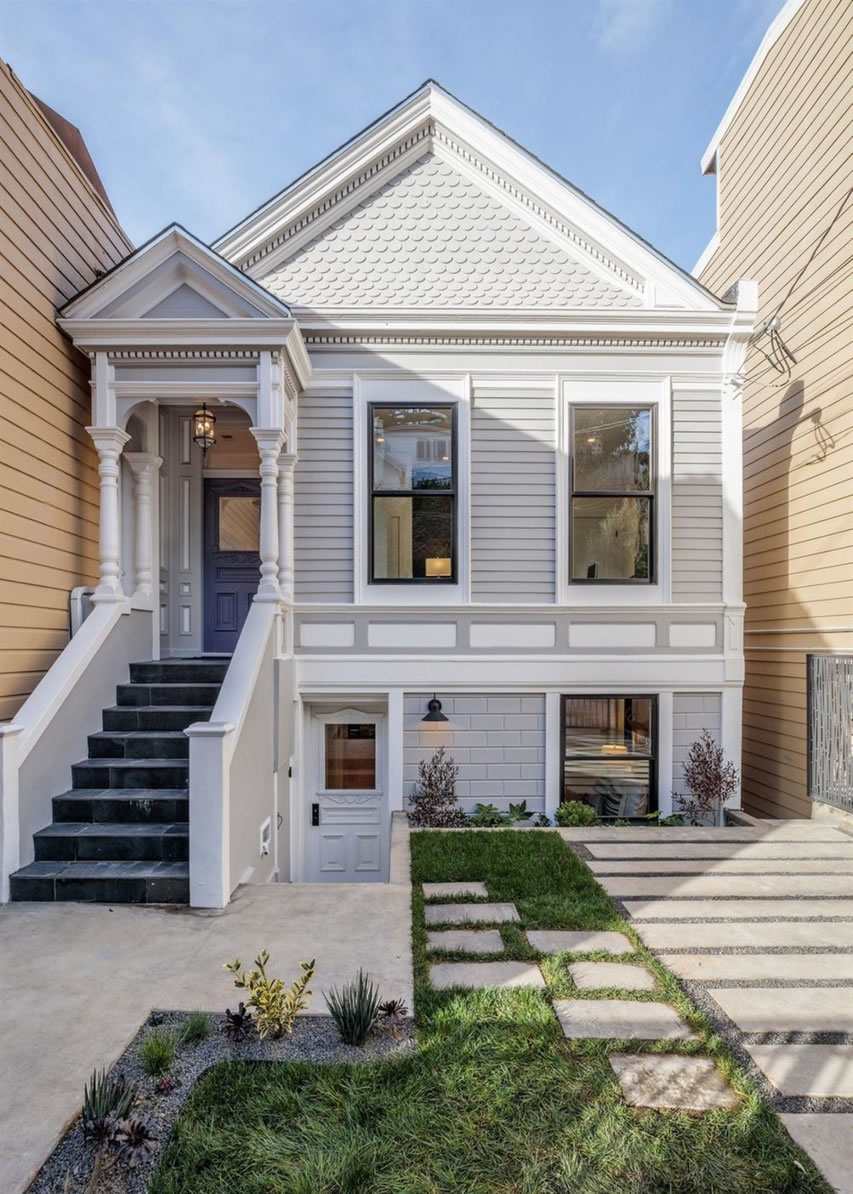Featuring panoramic skyline views, “from Twin Peaks to Downtown to the East Bay,” the newly renovated and “culturally significant” home at 147 Ripley Street, on the “desirable North Slope” of Bernal Heights, fetched $3.895 million in February of 2020, which was $100,000 under asking at the time.
Returned to the market priced at $4.250 million two months ago, a sale at which would have represented net appreciation of 9.1 percent over the past 42 months, the list price for the 3,334-square-foot home was reduced to $3.995 million at the end of September and then dropped to $3.495 million at the end of last month.
And having now closed escrow with a contract price of $3.400 million, the resale of 147 Ripley was officially “within 3 percent of asking” according to all industry stats and aggregate reports but 20 percent below its original list price and down 12.7 percent from the first quarter of 2020 on an apples-to-apples basis while the widely misreported index for “San Francisco” home values is “still up 30 percent” over the same period of time.






Ouch! The price drop is painful for the seller, but the monthly mortgage payment increase for the buyer is also painful:
Then: $3.9M purchase, 20% down, 3% rate, 30 year fixed: Monthly payment = $13,154
Now: $3.4M purchase, 20% down, 7.5% rate, 30 year fixed: Monthly payment = $19,019
So even though the buyer paid $500,000 less for the property, their mortgage is about $6,000 a month higher
Ouch is right.
So glad I got into the Boston market when I did at 2.9% (30y) in 2021. Now paying less than renting and I got 3 bedrooms and amazing views from the 3rd highest “peak” in Boston.
You’ll be saying “ouch” when you sell it, there’s zero chance you don’t lose money buying it when you did.
I don’t think that will be the case given I got in when prices were much lower. And I don’t plan on moving anywhere any time soon.
That might be true but both buyers paid cash!
If they both paid cash, the difference in opportunity cost is even worse:
Then: $3.9M at a risk free rate of return on a money market account of 0.06% = $195 a month
Now: $3.4M at a risk free rate of return on a money market account of 5.00% = $14,167 a month
Conflating the risk free rate of return on a money market account with one’s opportunity cost would constitute financial malpractice, to say the least.
The correct “opportunity cost” would mimic the allocation/returns of the individual’s investment portfolio for which said cost is being calculated. And at this price point, said portfolio would likely be heavily weighted towards equities, with the S&P 500 having gained around 49 percent over the same period of time.
While I appreciate the consistency and accuracy of Socketsite, I have to give voice to fatigue: I am tired of the near constant, smug, reporting about how much values have dropped and how it’s not being correctly reported except by you, except here, except for Socketsite no one else has it right. Ever. OK. I get it. Can we go three posts without the point being made that because of price drops people are under the impression that things are selling close to list? If all of your readers are such a cut above why do we have to hear the same point being made over and over?
The constant refrain “should catch none of our plugged in readers by surprise”—is not an encouragement it’s an indicator about the point of view Socketsite seems to be anxious to cultivate–that its a good thing to be all knowing, smug and superior as though that perspective is desirable or helpful when in fact, it’s everyhthing thats wrong with our city.
Also – is nothing ever turning a profit here in San Francisco – like – not once, not one time in several months? I mean – even a broken clock is right twice a day. Are all the smart people in SF just stupid–after all? Should we all pitch tents and be done with toilets since real estate is so stupid and foolish? I admire your specificity and constancy but am just so tired of your perspective. And you can print my name.
I assume these posts are meant as entertainment and not meant to be taken as serious market indicators, as the site somehow managed to scrounge up apples-to-apples losses even amidst the massive pandemic run up. And they are good entertainment! Far more entertaining than boring but probably more indicative apples-to-apples such as 4326 Cesar Chavez. So I say post away. But don’t post my name! I take no pride in my pleasure at rubbernecking these disasters.
Jamie and “Tone” should be aware that if they want to post their own positive return “apples” here, the editor usually allows discussion of it.
As far as 4326 Cesar Chavez, it was featured here a while back. Is that property “more indicative” of the market overall? Indicative of what?
I’m not an agent or any other “player” in the S.F. real estate “game”, but it looks like it was last sold in 2020 for $5,375,000 and just sold earlier this month for $5,500,000. But in between, it was listed for $5,995,000 in May of this year, then lowered to $5,750,000 in June, then de-listed and listed again for the same price in September (looks like the price per ft.² changed, however).
The seller of 4326 Cesar Chavez got out by the skin of their teeth.
Keep in mind that 4326 Cesar Chavez traded for $5.5 million in early 2018 as well, indicative of 0.0 percent net appreciation over the past six years for the dream Noe Valley home on an apples-to-apples basis, despite the fact that the widely misreported index for “San Francisco” home values is “still up 37 percent!” over the same period of time.
At the same time, the local whining and whinging index has jumped to levels last seen circa 2006 to 2008.
Amen. I am the furthest thing from a housing bull. SF real estate is in for a long and slow and yes painful period of (downward) nominal and real price discovery. But the editorial tone of this site and in its very specific emphasis on the negative side of owning residential RE in SF is grating. As a result, I’ve stopped visiting it with any regularity. Removed it from my favorites/bookmarks.
As for this house – it’s still ‘overpriced.’ I haven’t commented in years but the editor should probably be aware that some previously faithful readers are over it.
If you go back to read the older stories on this website during bull markets you will find plenty of articles about huge profits made in real estate. Now high interest rates have created a downturn and that’s why there’s currently more articles about losses.
As for the editor repeatedly calling out farcical claims of “selling above/at asking” when the property actually sold way below the seller’s expectations, I think everyone who’s read such stories here gets it pretty quickly. But there are new readers every day who aren’t aware of that ploy. I hear comparisons against the supposedly stable and objective “asking price” metric all the time from my friends and neighbors. So it is worth continued debunking to spread the understanding to the general public who are at an informational disadvantage in real estate transactions.
For most people the purchase of a home is by far the largest purchase in their lives. They deserve to be better informed and unfortunately cannot always rely on their agent to act on their client’s best interest.
Thank you. Not to mention these examples are cherry picked. There are plenty (recently, at least) of houses going at or above asking and at or above where they traded in 2020. This is selective reporting at its finest.
Despite the common rationalization and disparagement, we don’t “cherry pick” the sales we feature on the site nor do we go looking for sales that result in losses (or gains, as the case(s) may be).
But right on cue, you are absolutely right about there being plenty of properties selling at or even “over asking,” some for millions “over asking” in fact!
Bear markets can be exhausting and uncomfortable, particularly if you’ve been otherwise misled, but they also present plenty of opportunities for those who understand the actual drivers and trends (along with plenty of pitfalls and traps for those who don’t or choose to be un-plugged).
Not to mention the “zingers” informing the world that, gasp, “sold at asking price” doesn’t really mean anything. I am sure that everyone is shocked–shocked!!–to learn of this insight.
No kidding! It is shocking how many reports of “over asking!” sales remain in the press and industry reports and are easily distracted by a little tree! Which brings us back to the sales, trend(s) and forest at hand.
Wood that they could understand.
🙂
I understand. Gotta keep cranking out content.
The photos here appear to be older than what’s shown in the current listing, notably they took that awful 2000s Home Depot tile off the fireplace, but it doesn’t appear any major upgrades were made (or needed) since. Really nice property on a great block, but I’m always a bit surprised when Bernal fetches these prices.
Can anyone enlighten me as to what is “culturally significant” about a soulless white box that merely retains its old facade?
I wholeheartedly agree with the “soulless white box” assessment of the aesthetic (particularly the interior), but of course it’s that way because like many homes in San Francisco, it was optimized for maximizing resale value, and real estate agents are quite good at telling their clients that big white generic box interiors “are what buyers want”.
The listing agent probably included the “culturally significant” line because the home was “once the longtime home of noted San Francisco painter Betty Guy“, but of course that was prior to the white box-ing.
Thank you for that information.